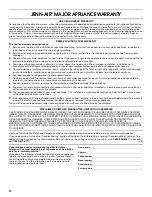
---7---
B. Safety precautions
T B3
11
Carbon monoxide
--- Never start the engine, or run it
indoors while the doors are closed as this may lead to
poisoning by carbon monoxide.
12
Downhill
--- Never drive downhill with the gear lever in
neutral or the clutch pedal pressed down. Check the
brakes often. The brake pedals should be locked together
when driving on the road. Always change down to a lower
gear before driving down a steep incline. When driving
downhill do not brake continuously---
danger of
overheating the brakes!
Do not let the engine go into
overdrive, it may damage.
13
Running speed
--- Adjust the speed to suit the driving
surface, visibility and load. Avoid any sudden increase or
reduction (braking) in the running speed as well as tight
turns at high speed. If care is not taken the tractor may tip
over or the load may be displaced.
IMPORTANT:
The maximum speed of the tractor must not
be altered.
Maximum operating forward speed is 40 Km/h, for safety
the maximum operating speed in reverse is
20 Km/h.
14
Power take---off driven attachments
--- When running
with power take---off driven attachments or machines it is
very important that the prescribed safety devices are used
and that they are in good condition. Serious accidents
have occurred due to failure to use prescribed safety
devices. Follow the directions given by the implement or
machine manufacturer.
15
Check links
--- When transporting implements on the
three---point linkage, the check links must be locked with
the locking pins.
16
Emergency exits
--- The cab is provided with six
emergency exits. These are the doors, side windows, rear
window and roof.
17
Stairs ---
Keep the stairs clean. Build up of dirt can
cause slippery conditions and can cause injury.
18
Trailer load
--- On tractors with trailers the load must
be properly secured. The load must not obstruct the
driver’s vision or cover lights and reflectors. Loads wich
project more than 1 m (39 in) behind the vehicle train
must be suitably marked. During day-time this is done
with a flag and during darkness with a red light and
reflector arrangement.
19
Trailer
--- A trailer should only be coupled to the
drawbar. A loaded drawbar must always be lowered with
the three---point linkage. Check that trailer brakes are
operating property and observe any special instructions
issued by the trailer manufacturer.
CAUTION: When the tractor is towing a
trailer the brake pedals must be locked
together. The brakes are not to be used
individually for steering.
CAUTION: When using a trailer make sure
that the hitch latch is locked.
WARNING: When using the trailer always
use the brakes, if the law requires. The
trailer brakes are recommended to use in 50
km/h models also in those countries, where
it is not required by the law.
20
Front---end loader
--- When working with a front loader
be sure that no one is in the working area. There is a
danger that the tractor may tip over when the loader is
lifted. The driver should put the front---end loader in the
down position before leaving the tractor. Any special
instructions issued by the loader manufacturer should
also be observed.
21
Running
--- Before driving, always check that the
tractor is in a safe condition for driving on the road. Rear
view mirrors should be adjusted for the correct viewing
angle before setting off. When towing an implement
whose centre of gravity is located at a significant distance
behind the tractor, the driver should remember that there
may be considerable sway during cornering.
22
Differential lock
--- The differential lock must only be
used when driving on loose or slippery ground. Never turn
on a firm surface with the differential lock engaged. The
differential lock should be disengaged when cornering.
A3565---11,1
23
Front axle loading
--- When driving on the road at least
20 % of the gross weight of the tractor must be on the
front axle. When lifting an implement the weight on the
front end of the tractor is reduced, and the steering ability
of the tractor is impaired or sometimes lost. Therefore
sufficient ballast weights should be carried. Ballast
weights should be mounted only at the points intended for
this purpose.





































